
Mobile is a city and the county seat of Mobile County, Alabama, United States. The population was 187,041 at the 2020 census. After a successful vote to annex areas west of the city limits in July 2023, Mobile's population increased to 204,689 residents, making it the second-most populous city in Alabama, after Huntsville. Mobile is the principal municipality of the Mobile metropolitan area, a region of 430,197 residents composed of Mobile and Washington counties; it is the third-largest metropolitan area in the state.

Spring Hill College is a private Jesuit college in Mobile, Alabama. It was founded in 1830 by Michael Portier, Bishop of Mobile. Along with being the oldest college or university in the state of Alabama, it was the first Catholic college in the South, is the fifth-oldest Catholic college in the United States, and is the third-oldest member of the Association of Jesuit Colleges and Universities.
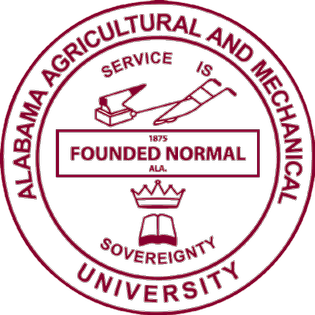
Alabama Agricultural and Mechanical University is a public historically black land-grant university in Normal, Huntsville, Alabama. Founded in 1875, it took its present name in 1969. It was one of about 180 "normal schools" founded by state governments in the 19th century to train teachers for the rapidly growing public common schools. It was one of 23 established to train African Americans to teach in segregated schools. Some closed but most steadily expanded their role and became state colleges in the early 20th century and state universities in the late 20th century. AAMU is a member-school of the Thurgood Marshall College Fund and is accredited by the Southern Association of Colleges and Schools. Alabama Agricultural and Mechanical University Historic District, also known as Normal Hill College Historic District, has 28 buildings and four structures listed in the United States National Register of Historic Places.

Murphy High School, in Mobile, Alabama, is a public high school operated by the Mobile County Public School System that educates grades 9–12.

Marion Military Institute, the Military College of Alabama, is a public military junior college in Marion, Alabama. Founded in 1842, it is the official state military college of Alabama and the nation's oldest military junior college.

The Cochrane–Africatown USA Bridge is a cable-stayed bridge carrying US 90/US 98 Truck across the Mobile River from the mainland to Blakeley Island in Mobile, Alabama.
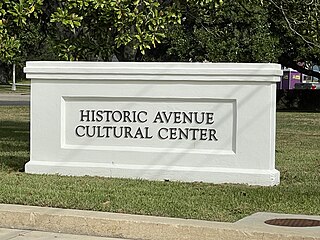
The architecturally and historically significant Historic Avenue Cultural Center is an exhibit and event space that serves as an anchor to Mobile, Alabama’s budding Civil Rights and Cultural Heritage District. From the early 1990s to approximately 2015, it served as the National African American Archives and Museum. Formerly known as the Davis Avenue Branch of Mobile Public Library, it was the lone Black library in Mobile County during segregation.

The Campground Historic District, also known as The Campground is a historic district in the city of Mobile, Alabama, United States. Named for the Old Camp Ground, a military encampment that occupied the property during the American Civil War, this historically African-American neighborhood was placed on the National Register of Historic Places on July 7, 2005. It is roughly bounded by Martin Luther King Jr. Avenue, Rylands Street, St. Stephens Road, and Ann Street. The district covers 370 acres (1.5 km2) and contains 166 contributing buildings. The houses range from shotgun houses to bungalows and date from the late 19th century to the middle 20th century.

Africatown, also known as AfricaTown USA and Plateau, is a historic community located three miles (5 km) north of downtown Mobile, Alabama. It was formed by a group of 32 West Africans, who in 1860 were bought and transported against their will in the last known illegal shipment of slaves to the United States. The Atlantic slave trade had been banned since 1808, but 110 slaves held by the Kingdom of Dahomey were smuggled into Mobile on the Clotilda, which was burned and scuttled to try to conceal its illicit cargo. More than 30 of these people, believed to be ethnic Yoruba, Ewe, and Fon, founded and created their own community in what became Africatown. They retained their West African customs and language into the 1950s, while their children and some elders also learned English. Cudjo Kazoola Lewis, a founder of Africatown, lived until 1935 and was long thought to be the last survivor of the slaves from the Clotilda living in Africatown.

The Thomaston Colored Institute, also known as the Thomaston Academy, is a historic African American school building in the town of Thomaston, Alabama, United States. This two-story brick building was completed in May 1910 as a private school by an African American religious group, the West Alabama Primitive Baptist Association.

Stone Street Baptist Church is a historic African-American Baptist church in Mobile, Alabama. The congregation was established well before the American Civil War, with Stone Street Baptist recognized today as one of Alabama's most influential African-American Baptist churches. It was placed on the National Register of Historic Places on August 8, 1985.

Carolina Hall is a historic residence in Mobile, Alabama, United States. It was built in 1832 in a Federal style and later altered to a Greek Revival style. It was placed on the National Register of Historic Places on January 18, 1973.

Aimwell Baptist Church is a historic African American church in Mobile, Alabama. The Baptist congregation was established in 1890 by two brothers. It took two years for the erection of the first building. The current building, with Gothic Revival influences, was designed in 1946 by Nathaniel Heningburg and incorporates elements from the original structure. It was added to the National Register of Historic Places on May 29, 2008.

The U. J. Cleveland House is a historic house located at 551 Charles Street in Mobile, Alabama. It is locally significant as an intact Gulf Coast Cottage with an unusual interior plan.
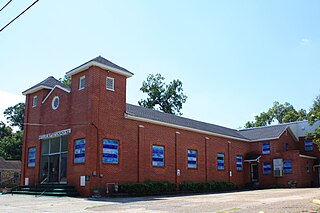
Mt. Olive Missionary Baptist Church No.1 is a historic Missionary Baptist church building in Mobile, Alabama. The church was built in 1916 by the local African American community. It was added to the National Register of Historic Places on May 29, 2008, based on its architectural significance.
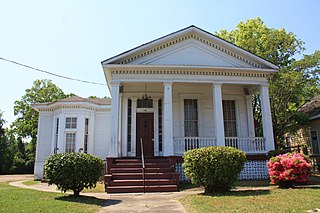
The Weems House, also referred to as Fowler Cottage, stands as a historic residence in Mobile, Alabama. Constructed in 1870, this single-story building exemplifies the late Greek Revival-style. Recognized on October 7, 1982, it was listed on the register National Register of Historic Places. Initially serving as a private residence, it transitioned ownership on July 18, 1991, when acquired by the Dragons Civic and Social Club, a local fraternal organization.

George Bigelow Rogers (1870–1945) was an American architect, best known for the wide variety of buildings that he designed in Mobile, Alabama, including mansions in historic European styles and other private residences, churches and public buildings, and the first 11-story skyscraper in Mobile and the Southeast United States. Many of his structures have been listed on the National Register of Historic Places.
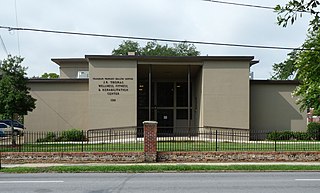
The Davis Avenue Recreation Center is a historic recreation facility in Mobile, Alabama. The facility was established in 1921 as the first public leisure center for African Americans in segregated Mobile. Initially known as the Davis Avenue Community House, it also featured tennis courts, a swimming pool, and a small park. The need for a larger facility was soon realized, and in 1936 the current structure was completed. It was the only public recreation facility in Mobile built using Works Progress Administration funds. It was added to the National Register of Historic Places on June 27, 2011, due to its significance to the African American history in the city.
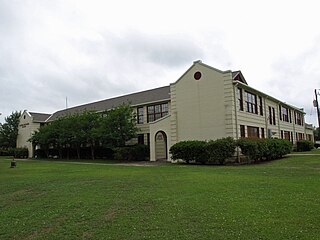
The Caldwell School is a historic former black school building in Mobile, Alabama. The school, originally named the Broad Street Academy, was the first public high school for African Americans in the city. It was founded in 1887, with William A. Caldwell serving as the first principal.
The following is a timeline of the history of the city of Mobile, Alabama, USA.























